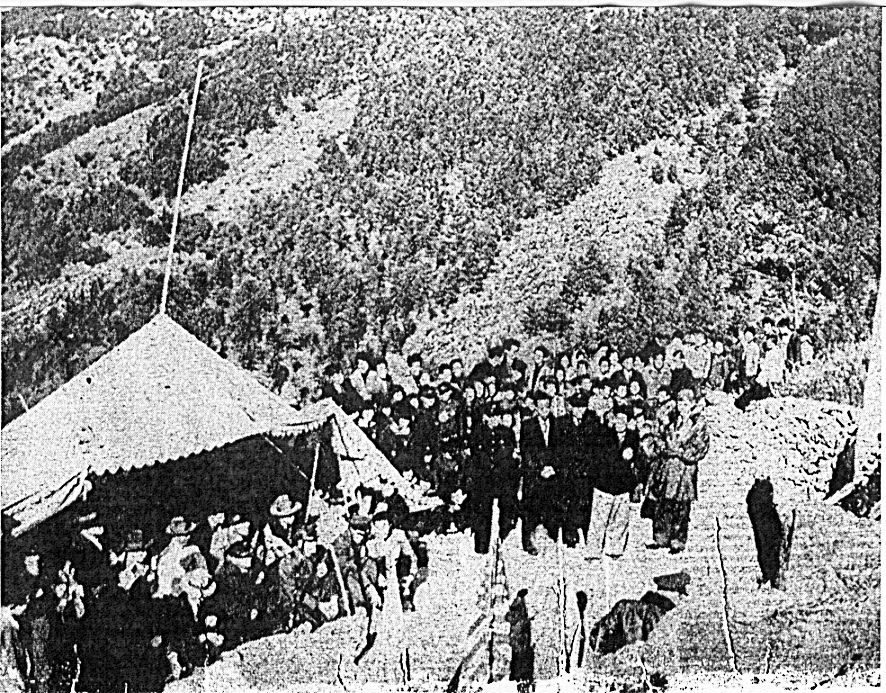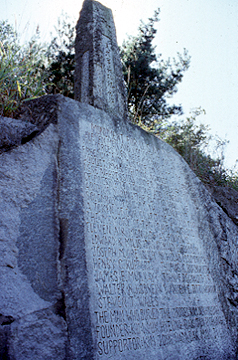

The memorial is situated at the crash site, just below the peak of Mangwoon-san
Kim Duk-hyung (circa 1950s)
...Meanwhile, at the crash site on Namhae Island, Japanese authorities and Korean laborers searched the wreckage of the B-24 for useful parts, leaving the bodies of the crew to rot. One of the Koreans at the site, was a civil-servant working for the county government in Namhae named Kim Duk Hyung (김덕형).
Although no one else would inter the dead airmen, Kim Duk Hyung, reminded of his brother's recent death in a similar accident while serving in the Japanese military in Burma, took it upon himself to properly bury them. He gathered up all the items needed for the burial, and collected what identification he could find from the bodies.
He formed a mound with rocks from the hillside and placed a cross of pine tree branches on top of the graves. The next day, the Japanese found out about the burial and arrested Mr. Kim. For his selfless act, Mr. Kim suffered torture at the hands of the Japanese during his confinement. Luckily, the war ended on August 15th, and Mr. Kim awoke that day to find his cell door open and the jail abandoned.
He left jail injured, but alive.
After the war, Southern Korea was under U.S. Military Government occupation (1945-1948). It was during this time that the U.S military first learned the fate of the missing crew.
Army Captain Charles DeLaney was appointed military governor of Hadong, Sachon, and Namhae island, when he learned of the story of the American airmen while attempting to deal with the activities of Namhae's Red Peasant Union (농민초합).
Kim Duk Hyung led Captain DeLaney to the crash site, where the names of the crew were identified. Their remains were soon shipped back to the U.S. However, it was only after DeLaney returned home to Carbondale, Pennsylvania in mid-1946 that he learned that the pilot of the plane, Ed Mills, was also from Carbondale.
After a chance meeting with members of the Mills family, it was confirmed that one of the pilots who perished at the crash site DeLaney had visited in Korea was from his own hometown.
The eleven airmen were to be the only U.S. casualties in Korea during the Second World War.
Back in Korea, Kim Duk Hyung resolved to build a memorial at the crash site for the airmen, who he believed had fought and died for freedom and justice against Japanese aggression. In 1948, Mr. Kim was granted Korean government approval to organize the "Memorial Activities Association for the U.S. Air Force" (미공군 전공기념사업협회).
He raised enough money by 1956 to build a twelve-foot tall granite monument at the site on Mt. Mangwoon. This was done in spite of interruptions by communist partisans in the late 40's, and another dose of torture, this time at the hands of the North Korean army during the Korean Civil War. The monument dedication took place on November 30, 1956, and was attended by high-ranking South Korean and U.S. military and civilian officials. It has since been cared for by Mr. Kim and his supporters.
 |
 |
The front face of the monument's spire freatures Chinese calligraphy written by Syngman Rhee The base of the monument is written in English, with the names of the airmen and others involved in making the memorial

Read the full script of the monument